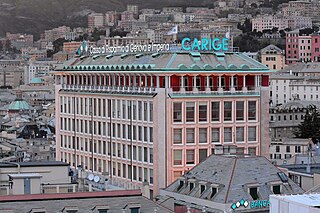
The spinning jenny is a multi-spindle spinning frame, and was one of the key developments in the industrialisation of textile manufacturing during the early Industrial Revolution. It was invented in 1764-1765 by James Hargreaves in Stan hill, Oswaldtwistle, Lancashire in England.

Crespi d'Adda is a village in northern Italian and hamlet (frazione) of Capriate San Gervasio, a municipality in the province of Bergamo, Lombardy. It is a historic settlement and an outstanding example of the 19th and early 20th-century "company towns" built in Europe and North America by enlightened industrialists to meet the workers' needs. The site is still intact and is partly used for industrial purposes, although changing economic and social conditions now threaten its survival. Since 1995 it has been on UNESCO's list of World Heritage Sites.
Loro Piana is an Italian company specialising in clothing and textile products, claiming to be the world's largest cashmere manufacturer. It was founded in 1924 and is owned by French multinational holding and conglomerate LVMH.

Gianfranco Ferré was an Italian fashion designer also known as "the architect of fashion" for his background and his original attitude toward creating fashion design.
Patons and Baldwins was a leading British manufacturer of knitting yarn. It was an original constituent of the FT 30 index of leading companies on the London Stock Exchange.

Feltex Carpets is a manufacturer of residential and commercial carpets.
Edinburgh Woollen Mill (EWM) is a Carlisle-based retailer specialising in clothing, along with interests in homewares and destination shopping for tourists. It was previously owned by the Dubai-based British billionaire Philip Day.

Valentino S.p.A. is an Italian luxury fashion house founded in 1960 by Valentino Garavani and part of the Valentino Fashion Group. From October 2008, the creative director is Pierpaolo Piccioli, jointly with Maria Grazia Chiuri from 2008 to 2016. Piccioli departed Valentino in 2024. The company is headquartered in Milan, while the creative direction is in Rome. The Valentino Beauty license is held by L'Oreal.

Beatrice dei Principi Borromeo Arese Taverna is an Italian journalist and fashion model. Born into an aristocratic family, she graduated from Bocconi University and Columbia University. She became a journalist for il Fatto Quotidiano, Newsweek and Daily Beast. She also worked as a broadcast journalist for Anno Zero on Rai 2 and hosted a weekly show on the Radio 105 Network. She married Pierre Casiraghi, a son of Caroline, Princess of Hanover, in 2015 and had two children. As a model, she became the 2021 ambassador of Dior.

The history of Italian fashion is a chronological record of the events and people that impacted and evolved Italian fashion into what it is today. From the Middle Ages, Italian fashion has been popular internationally, with cities in Italy producing textiles like velvet, silk, and wool. During the Middle Ages and Renaissance, Italian fashion for both men and women was extravagant and expensive, but the fashion industry declined during the industrialization of Italy. Many modern Italian fashion brands were founded in the late 19th and early 20th centuries, and in the 1950s and 1960s, Italian fashion regained popularity worldwide. While many clients of Italian fashion designers are celebrities, Italian fashion brands also focus on ready-to-wear clothes.
Pietro Antonio Loro Piana was an Italian engineer and entrepreneur. He founded the textile company Loro Piana

Banca Carige S.p.A., historically known as Cassa di Risparmio di Genova e Imperia (Ca.Ri.Ge.) was an Italian bank based in Genoa, with more than 500 bank branches in Italy, prior to its acquisition by BPER Banca in February 2022. The predecessor of the bank, a mount of piety, was founded in 1483 in Genoa, the Republic of Genoa. Banca Carige and its subsidiaries were known as Banca Carige Group. The banking group was one of the large banking groups in Italy, and as such, was supervised by the European Central Bank. In 2017, the banking group had 529 branches throughout Italy, with one branch in Nice, France, about 37.2% of branches were located in the home region Liguria. In November 2022, Banca Carige was fully incorporated into BPER Banca and ceased to exist as a separate entity.

The woollen industry in Wales was at times the country's most important industry, though it often struggled to compete with the better-funded woollen mills in the north of England, and almost disappeared during the 20th century. There is continued demand for quality Welsh woollen products.

Kerry Woollen Mills are historic wool mills based just off the Ring of Kerry.
Stellantis Heritage is a department established to protect and promote the historic legacy –both automotive and archival– of the Italian brands Alfa Romeo, Fiat, Lancia and Abarth. It was founded in Torino in 2015 to coordinate all the activities which, up to that moment, had been conducted individually by the brands to promote their historical and cultural heritage.

Guido Leto was an Italian police official, head of the OVRA, the secret police of the Fascist regime, from 1938 to 1945. Throughout his career as a policeman he served under the Kingdom of Italy, the Italian Social Republic, and the Italian Republic.
Fratelli Piacenza S.p.A. is an Italian fabric mill and family business established in 1733. Fratelli Piacenza has been accepted as a member house in the Henokiens, an association of companies that have been continuously operating and remain family-owned for 200 years or more.











